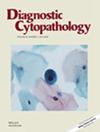What Is a Significant Nuclear Groove in Thyroid Fine Needle Aspiration Cytology?
Abstract
Background
Nuclear grooves are an important diagnostic feature in thyroid fine needle aspiration (FNA). However, their exact role remains undefined.
Materials and Methods
This study includes both retrospective and prospective analyses of the significance of identifying and counting deep grooves under low-power magnification (20×) in Pap-stained cytology smears for the classification of thyroid FNA results and, consequently, patient management.
Result
Two cut-off points have been identified to stratify thyroid smears into three categories: benign with no grooves identified, 1–9 grooves in indeterminate cases, and ≥ 10 grooves in papillary thyroid carcinoma (PTC). Deep groove identification and counting under 20× magnification are highly reproducible between observers (K = 0.61). Using groove-based criteria instead of the archival Bethesda System for Reporting Thyroid Cytology (BSRTC) leads to a significantly higher diagnosis of follicular adenomas as benign (p < 0.0001), with fewer noninvasive follicular thyroid neoplasms with papillary-like nuclear features (NIFTP) categorized as benign (p = 0.002). The follicular variant of papillary carcinomas (FV-PTC), previously considered indeterminate, showed a significant decline (p < 0.001), and false-negative diagnoses of PTC and FV-PTC were eliminated. A significant difference favoring the groove-based approach was noted regarding specificity and positive (PLR) and negative (NLR) likelihood ratios (p = 0.0014). Finally, a substantial reduction in the false-negative rate was observed prospectively (p = 0.0014). The number of unnecessary surgeries among benign cases has decreased.
Conclusion
Incorporating the presence and frequency of deep nuclear grooves seen at 20× magnification improves the outcome of thyroid FNA classification and overall patient management.

 求助内容:
求助内容: 应助结果提醒方式:
应助结果提醒方式:


